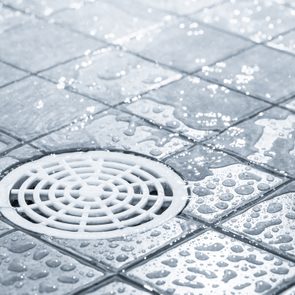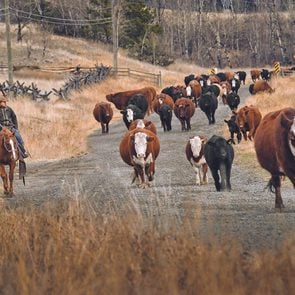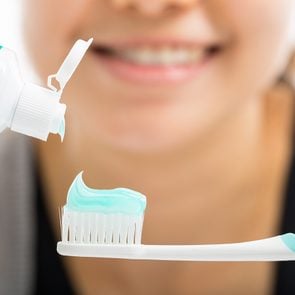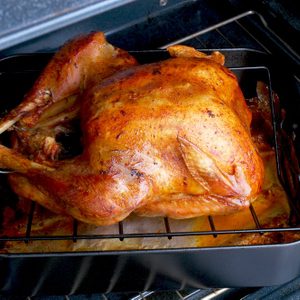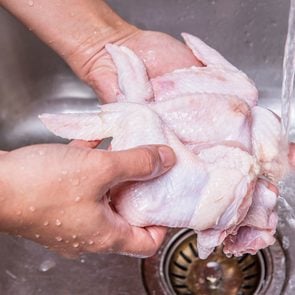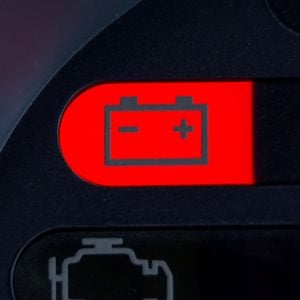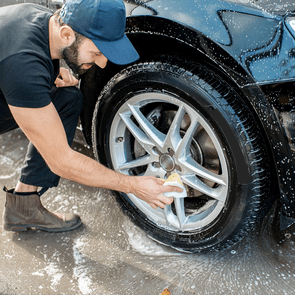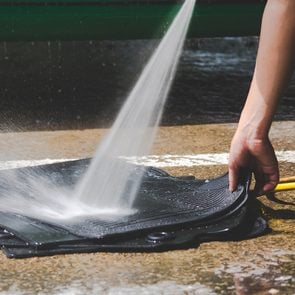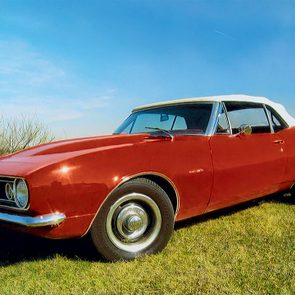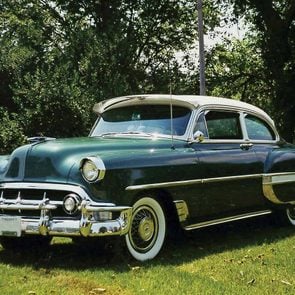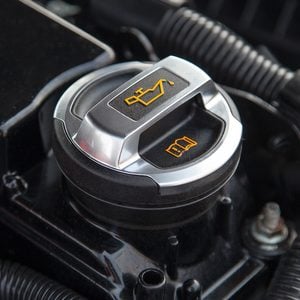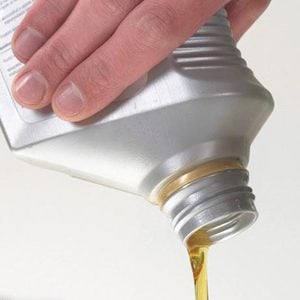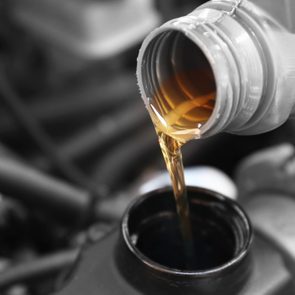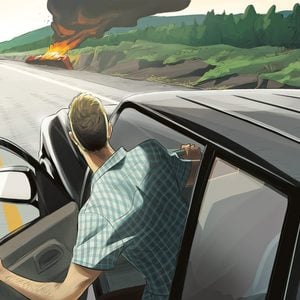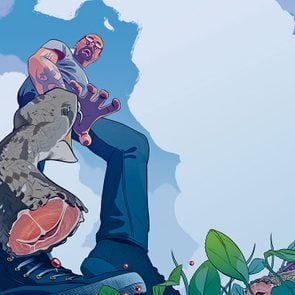Bleach is a staple in just about everybody’s arsenal of house cleaning products. Common household laundry bleach contains sodium hypochlorite as its active ingredient, the source of its fabric-brightening power, and its ability to disinfect surfaces from light switches to doorknobs.
When does bleach expire?
To figure out when a product expires, it’s good to know out when the product was made. According to the Clorox website, the production code on the neck of the bottle allows you to figure out how old the bottle of bleach actually is. But how would you be able to decipher this code? Clorox breaks it down by using the example code A81421321CA3. Moving from left to right, the plant number is “A8,” the last two numbers of the year it was made is “14,” and the day of the year the bottle was made is “213.” That translates to a bleach bottle being made on the 213th day of the year, or August 1st, 2014.
According to The Scripps Research Institute, bleach can last about six months. After that, “bleach starts to degrade. Even in its original bottle, bleach becomes 20 per cent less effective as each year goes by.” It’s important to know how to correctly store your bottle of bleach. According to the Clorox website, a bottle of Clorox Regular Bleach “should be stored between 10°C and 21°C, and away from direct sunlight,” and that pertains to bottles that are both sealed and opened. Clorox states that a bottle of beach that has been correctly stored has a shelf life for about one year. They recommend replacing after one year since sodium hypochlorite begins to break down.
How can you tell if a bottle of bleach has expired?
Not sure whether your bottle of bleach is still good at six months or even a year? Thankfully, Clorox has broken that down as well. If you can detect any bleach smell at all, then that means there’s still some active bleach left in the bottle. However, you want to use a bit more than you normally would during laundry and cleaning because it would be weaker.
How to dispose of expired bleach
If you’re looking to get rid of bleach, Clorox recommends to simply flush it down the toilet because “any small amount of sodium hypochlorite active that may remain will finish breaking down as it travels through your home’s pipes and out to the sewer.”
Next, find out 12 things you should never pour down the drain.

This story is about weaving Western Canada together province by province. It’s about what can be accomplished when people are resourceful and passionate, have common unity and are determined to make a dream a reality. Today, as always, we know there is strength in unity. The Trans Canada Yellowhead Highway Association (TCYHA) has proven this beyond a doubt.
Origins of the Yellowhead Highway
This story reaches back to the 1800s, when a blond-haired Iroquois Métis traded and trapped for the North West Company, now known as the Hudson’s Bay Company. His name was Pierre Bostonais (a.k.a. Pierre Hatsination). He had yellow-blond hair, so the French voyageurs nicknamed him “Tête Jaune,” which means Yellow Head. He joined David Thompson and explored what was then known as the Leather Pass; he built a cache for his furs near the Grand Forks River, at what is now called Tête Jaune Cache.
In the fall of 1828, near the headwaters of the Smoky River, Pierre Bostonais and his family were killed, along with others, by the Danezaa (Beaver) tribe in retaliation for the Iroquois encroachment into Danezaa territory. In honour of Pierre’s extensive exploration efforts, the North West Company renamed the Leather Pass “Tête Jaune Pass,” or Yellowhead Pass. Today, a magnificent highway continues to honour his name.
Around the same time period that David Thompson met up with Tête Jaune to explore the Leather Pass, Thompson also discovered a pass at the headwaters of the Athabasca River. This discovery enabled traders to follow a river route up the Saskatchewan River to Fort Edmonton, overland to the Athabasca, upstream to Jasper House and across the mountains to Boat Encampment, Fort Kamloops and Fort Vermilion. This discovery let the Hudson’s Bay leather brigades travel through the Yellowhead Pass, transporting valuable furs from the District of Saskatchewan to New Caledonia.
By the 1830s, after Fort Garry was established in Winnipeg, the eastern portion of the route was being used as a transportation corridor, connecting to the Yellowhead Pass. Red River carts struggled along this treacherous land route in 1840 to Fort Edmonton. In 1856, the Cariboo Gold Rush was in the making and the miners used the Yellowhead route to connect to the routes north to Alaska. Kate Ryan was one of the first women to undertake this adventure, travelling as a cook for the North West Mounted Police (NWMP). (Unlike America, Canada’s West had law and order prior to the influx of settlers. This was due in part to the respect and friendship between the NWMP’s Major Walsh and Sitting Bull.)
Several years later, in 1862, Overlanders travelled the treacherous Yellowhead Pass to get to Kamloops and Prince George to settle into their new homes. Catherine Schubert, the only woman, arrived safely in Fort Kamloops with her husband Augustus and three children. Not only was Catherine the only woman but she also kept it a secret that she was four months pregnant when they left Fort Garry. On October 13, 1862, she gave birth to a baby girl with the aid of local Native women.

The Direct Route
The Dominion of Canada, worried about America seizing disputed territories, passed legislation for the government to deed land and lawfully populate the West. In 1873, the NWMP established an outpost in Shoal Lake, Manitoba, on the edge of what was referred to as Rupert’s Land, or No Man’s Land.
The Dominion of Canada took control of Rupert’s Land from the Hudson’s Bay Company and hired Sir Sandford Fleming, a Scottish civil engineer, to survey possible routes for a new railway across the Prairies and through the Canadian Rockies. It was Fleming’s recommendation to the government that the Yellowhead Pass was the easiest, safest and most direct route to the Pacific. After all, the highest point on the Yellowhead is located in Alberta at Obed Summit (1,163.9 metres, or 3,819 feet), a mere 128.4 kilometres from the gates of Jasper National Park.
As far back as 1926, efforts were made to encourage the federal government to link the highway systems in Alberta and British Columbia. Arthur Edward Cushing Read, the postmaster at the lodge in Longworth, B.C., was a fervent supporter for the completion of the B.C. section of the highway. His passion for this project got him elected as president of the newly formed Yellowhead Highway Association with Don A. McPhee as vice president and J.O. Wilson as secretary-treasurer. In addition, Louis Le Bourdais, in his role as Minister of the Legislative Assembly (MLA) for Quesnel Land as well as Mark Connolly, MLA for Fraser Lake, provided their support to this worthy cause, along with W.A.E. Wall and George Ogston.
By the Dirty Thirties, the Yellowhead Highway Association had influenced the completion of the highway to the West from McBride to Tête Jaune Cache and north along the Thompson Route to Valemount.
With the Depression, government finances became scarce, but that didn’t stop these dedicated pioneers. Yellowhead Highway Association President Arthur Read encouraged everyone to keep up their enthusiasm and reminded them that, due to military requirements, there was hope to complete the breach to join up with the Alaska Highway.
In “Remembering,” Valerie Giles, Ph.D., notes, “Officially, the proposed Yellowhead Highway was called the Northern Trans-Provincial Highway.” She also notes that in early April 1942, the Defence Department announced they were going to start road construction “with all speed.” There was little doubt that this change of heart was, in no small part, due to World War II and the concentrated efforts of the United States to construct the Alaska Highway.
Regrettably, with the death of Arthur Read in 1945, the initiative ground to a halt and the Yellowhead Highway Association ceased to exist.

The cause was once again taken up, in 1947, by the Board of Trade, with MLA John McInnis of Fort George moving things forward. The B.C. provincial government declared it didn’t have enough men or money due to the war efforts. Undaunted, mill owners in the Prince George region took stock of what equipment they had and proposed they would donate the necessary equipment for three months to keep building the road. The boards of trade from Kamloops to McBride, in British Columbia, supported the initiative and organized a caravan from Kamloops to Blue River and back to gain public support. In July, Valemount hosted a meeting to open the road from Valemount to Blue River and agreed to provide the equipment needed to get the job done. In August, the provincial government finally coughed up $20,000 to assist in making the route passable and for its maintenance.
During the same period in 1947, Canada’s lack of a cross-country highway was deemed to be a national disgrace. Public opinion was now in support of action by the various governments. On July 8 and 9, 1947, the Trans Canada Highway System Association (Yellowhead Route), under the presidency of Edmonton Mayor Harry Ainlay, held a meeting in Blue River with government officials and highly respected business and professional men of the day attending. And so began the Trans Canada Yellowhead Highway Association.
A Common Goal
For more than 70 years, this nonprofit organization has represented communities along the highway from the heart of Manitoba to the shores of British Columbia and through the B.C. interior to Hope, encouraging and pushing the provincial and federal governments to obtain funding for building and maintaining Trans Canada Yellowhead Highways No. 16 and No. 5, and to encourage tourism on behalf of the dozens of communities along the corridor.
For 75 years, from The Forks in Winnipeg to the Queen Charlotte Islands and south from Valemount to Hope, more than 100 communities have worked passionately together, putting aside any local issues with one another to work towards a common goal.
Today, we can all experience the end result of these extensive efforts. Trans Canada Yellowhead Highways No. 16 and No. 5 are major transportation corridors for Canada’s goods and services, as well as a scenic and historic drive. In the April-May 2008 edition of Our Canada, I wrote an article from a tourist’s perspective about this magnificent highway, which now stretches 3,500 kilometres through the four western provinces, with direct access to five national parks, 90 provincial parks and three National Historic Sites. Through Prairie flatlands to majestic mountains, this park-to-park highway captures a huge part of Canada’s history and features some of Canada’s most breathtaking scenery. It took the courage, passion and fortitude of people like you and me to make a dream a reality.
Next, check out this photographic tour of the western provinces of Canada.
If you come out one morning and discover a dead battery, it could be a one-time quirk from leaving the interior or headlights on overnight, especially if the battery revives with a jump-start. But a “one-time” no-start condition should be a warning that there may be a problem lurking that will leave you stranded on the side of the road. Here are the most common reasons why a battery keeps losing its charge.
Note: A battery contains sulfuric acid that can cause serious burns. Always wear gloves and eye protection when working around a battery or jump-starting a car. If you come into direct contact with battery acid, flush with plenty of water and get medical attention immediately.
Charging system problems
A faulty charging system will drain the battery if you’re using the radio, lights and other high-current-draw accessories while driving. Although the charging system consists of many parts, the alternator is the heart of the system. It recharges the battery when the engine is running.
A defective alternator can kill a battery if bad diodes or an internal voltage regulator prevents it from charging the battery. Or a diode can leak, allowing current to flow after the vehicle engine is shut off. A worn or loose drive belt, or a weak belt tensioner, will also interfere with charging.
Parasitic drain
Parasitic drains are also capable of killing a battery. They’re caused by short circuit or an electrical device that remains “on” when it should be off. Common parasitic drains include bad light switches in the glove box, under the hood or in the trunk. The bad switch allows these lights to come on when they shouldn’t, then doesn’t turn them off. Late model vehicles have clocks, radio presets, security alarms, computer modules and other sophisticated systems that constantly drain the battery. If your car sits for a few weeks without being started, these normal drains may lower the battery voltage enough on a two- or three-year-old battery to keep your engine from turning over.
Poorly-installed aftermarket accessories like sound system amps, lighting, power inverters can drain the battery and cause mayhem with sensitive electrical systems. Plus, they can be extremely difficult to pin down.
Short drives
Starting your car draws the most power from the battery. Not giving the alternator a chance to recharge the battery could explain why the battery continues to die, or doesn’t seem to last long as it should.
But it could be the battery
A weak or poorly maintained battery is usually the main reason a battery dies. If you do not have a sealed battery, remove the battery caps and top off the battery “cells” (about ½- to one-inch from the top of the battery) with distilled water. A dirty battery top can “leak voltage” between the terminals draining the battery when not in use. Note: Before removing the battery caps, clean the top of the battery with a brush and solution of ¼-cup baking soda and one-quart clean water to keep dirt and debris from falling into the cells.
Make sure the battery is securely seated in the battery tray. A loose battery that is bouncing around can short internally, causing it to discharge. Having the positive terminal short to the vehicle body can result in a fire or explosion. And remember, batteries do not last forever. Depending on the climate and driving conditions, expect to replace your battery every three to five years.
Battery terminals
Corroded or loose battery terminals can not only keep your car from starting, but prevent the battery from fully recharging as you drive. Clean the terminals with a baking soda solution before removing them from the battery (ALWAYS REMOVE THE NEGATIVE CABLE FIRST!). Clean the terminals and battery posts with a wire brush, then snugly tighten.
Extreme temperatures
Extreme temperatures wreak havoc with a battery’s chemistry. Cold slows the chemical reaction, heat speeds it up. The high heat of summer keeps a battery from recharging because water evaporates from the battery’s electrolyte, preventing chemical energy from converting back to electrical energy. Adding distilled water to a battery may rejuvenate the electrolyte. If not, it’s time for a new battery.
(Battery electrolyte is a mixture of water and sulfuric acid that produces a liquid that conducts electricity. Because it’s highly acidic, it’s referred to as battery acid. It’s the same principal as the time-honoured fifth-grade science experiment where you stuck a nail and a penny in a lemon. The lemon’s citric acid conducted a tiny amount of measurable electricity/voltage between the two metal objects.)
On the other hand, a battery only has half of its potential power at 0°F/-18°C. At the same time motor oil thickens, requiring more battery power to start a vehicle. Never attempt to jump-start a frozen battery—it can explode. It also means it’s time for a new battery.
All batteries eventually die of old age. Basic battery maintenance can prolong a battery’s life and help prevent it from discharging. Once per month, check the battery terminals for corrosion and be sure they are clean and tight. Check the electrolyte level in batteries with removable caps and make sure the battery is secured in its tray.
Next, find out how to test a car battery, step by step.
Over the last two-and-a-half years, Canadian dentists have reported an increase in tooth fractures, damaged fillings and jaw soreness among their patients. While it’s too early to say for sure, some experts surmise that the stress of the pandemic has caused an uptick in the number of people who grind their teeth and clench their jaw—behaviours known as bruxism.
Bruxism is involuntary, can happen while a person is awake or asleep and can lead to pain and tightness in the jaw, neck or face, as well as tooth sensitivity. Because of this, bruxers are three times more likely than non-bruxers to experience headaches.
What causes teeth grinding?
There’s a strong link between high levels of stress or anxiety and bruxism—particularly when it comes to daytime clenching. While more research needs to be done to pinpoint the correlation, some studies suggest that tooth clenching while awake may be a coping mechanism, much like how some people bite their nails or find themselves tapping their feet.
Stress isn’t the only cause. If you drink an excessive amount of caffeine (more than six cups a day) or alcohol—both of which trigger jaw muscles to hyperactivate—you’re also more prone to bruxism. In fact, it’s been found that heavy alcohol consumption (three or more drinks a day) doubles a patient’s chance of grinding their teeth and clenching their jaw while sleeping.
One theory about bruxism is that humans first began to grind their teeth at night as part of our ancient fight-or-flight response, triggered by our sympathetic nervous system.
Gilles Lavigne, a professor in the faculty of dentistry at the University of Montreal, compares this system, which operates without our conscious awareness, to an internal cuckoo clock: every 20 to 40 seconds, the cuckoo pops out of the clock face (in this case, deep sleep) and scans the surroundings for signs of danger. If there are none, it goes back inside, and we continue to sleep. But if it senses a new smell or sound, for example, the cuckoo starts to chime, and our muscles, including those in our jaw, tense in preparation to face the threat or run.

How to stop grinding your teeth at night
To prevent tooth damage from nighttime bruxing, a dentist can prescribe a personalized mouthguard that protects against wear and tear. However, that doesn’t address the root of the problem—whether it’s stress or over-caffeinating—and it’s possible for bruxing to lead to chronic pain or even cause the jaw to freeze into place, a condition known as lockjaw. (Here are 13 signs you need to see a dentist right away.)
For this reason, if your bruxing becomes more frequent or painful, you should consider taking a holistic approach to treating it. A psychological counsellor can help you determine the source of your stress or anxiety, as well as assist with cutting down on caffeine and alcohol. Meanwhile, a physiotherapist can alleviate pain by massaging the muscles of the head and face and by using a technique called dry needling, where needles are inserted into muscles in the jaw to release tension.
The connection between screen-time and bruxism
Karim Meghji, a physiotherapist in Calgary, adds that he’ll also help people with their overall body posture, since leaning into a computer or spending a lot of time on the couch can lead to more bruxing. “When people’s heads are sitting forward, their necks are getting stressed and they’re basically sitting in a compressed posture,” he says, explaining that this puts pressure on the neck and jaw muscles, causing them to stay activated—and clenched—when they should instead be relaxed.
While the pandemic has certainly increased bad posture behaviours, Meghji says there’s been a silver lining: patients, with more time on their hands, have relied less on quick-fix treatments like mouthguards and are more open to the idea of investing in long-term changes to their lifestyles and mental health.
Now that you know how to stop grinding your teeth at night, find out the signs of disease your teeth can reveal.

In a world of 30-second how-to videos and viral TikTok hacks, it can be tough to discern fact from fiction. Personally, I’m always skeptical and can typically see through those that are simply smoke and mirrors.
However, once in a while, one of these viral hacks is simply too tempting not to try. That’s how I felt when I stumbled upon a claim that using a hairdryer is the secret to a perfectly crispy skin-on chicken or turkey. I knew instantly this was a Thanksgiving hack that I should put to the test!
What Drying the Skin on a Turkey Does
If you’re roasting a turkey, most recipes recommend that you pat the turkey dry with paper towels to remove excess moisture from the skin before cooking. This helps the turkey’s skin brown evenly and get crispy in the oven.
Why a Hairdryer May Work Better Than Paper Towels
I’ve used the paper towel method for years, but a hairdryer is such an obvious replacement that I can’t believe I haven’t tried it before, let alone seen recommended in other poultry recipes!
Unlike paper towels that are only able to remove moisture on the surface of the skin, the hot air of a hairdryer is able to penetrate under the turkey’s skin and remove any moisture that may be lingering under the surface. The result, in theory, is an extra crispy, golden turkey skin.
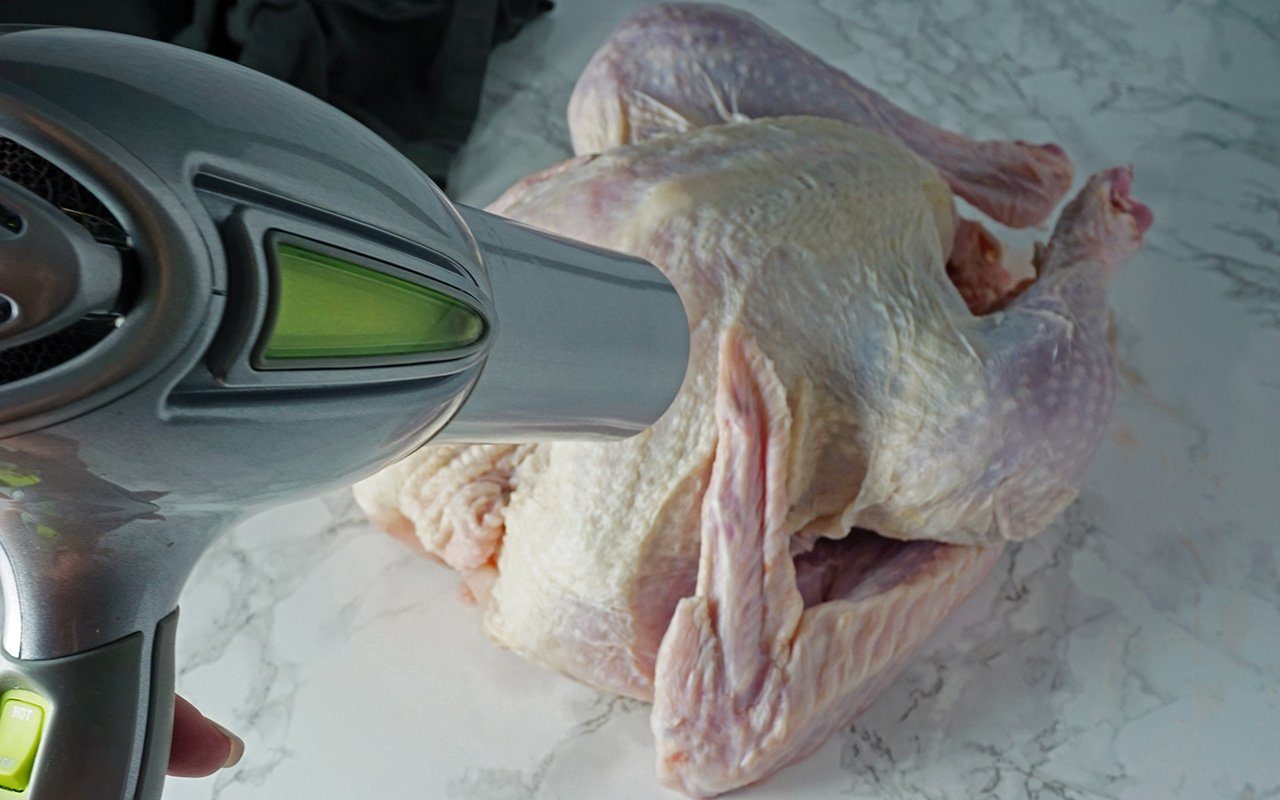
How to Use a Hairdryer on a Turkey
I did some research and discovered that this method wasn’t an entirely new idea. Surprisingly, giving your bird a salon-quality blowout has been around in the US since at least 1978, when it was introduced by the famed culinary mastermind Marcella Hazan in her cookbook More Classic Italian Cooking. But this method is hardly Italian! It’s actually of Chinese origin and often used by chefs when making a classic Peking duck.
Here’s how to do it step by step:
- Thaw: Completely thaw turkey in the refrigerator.
- Get rid of the extras: Remove turkey from packaging and remove any organ meat or gravy packets from the cavity of the bird.
- Pat dry: Use paper towels to give the turkey an initial pat-down inside and outside, absorbing any water or juices sitting on the skin’s surface or pooling inside the cavity.
- Break out the hairdryer: Turn a hairdryer to its highest, warmest setting. Blowdry the skin and cavity of the turkey thoroughly on all sides until the skin feels completely dry, about 10 to 15 minutes depending on the size of your turkey. Ultimately, you don’t want any dampness felt on the skin.
- Cook as normal: Continue to prep and season the turkey as directed by your chosen recipe and cook as directed. For testing purposes, I used this roasted sage turkey recipe.
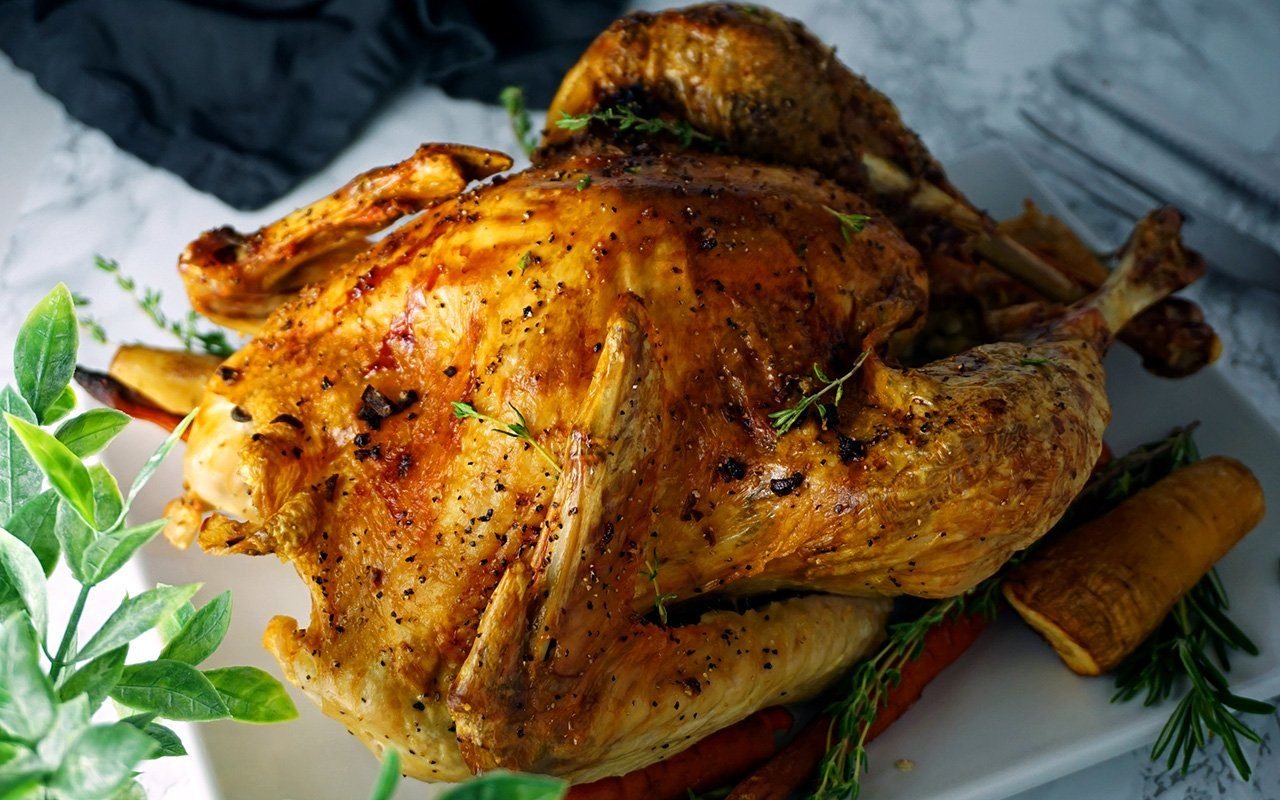
The Results
My oh my, this turkey trick did not disappoint! I noticed the turkey skin browning in the oven after just 15 to 20 minutes of cooking—which is a lot sooner than usual. Because the skin is already so dry, the oven doesn’t have to work as hard to dry out the skin. Instead, it can skip right to browning and crisping.
And indeed, it was crispy. Not only was the skin on this bird extra-crisp, I felt it browned more evenly than other turkeys I’ve roasted in the past. I’m assuming this is due to the fact that the hairdryer helped dry the skin more evenly so there weren’t any damp spots on the bird as it cooked in the oven.
Other Methods That Will Make the Skin Crispy
Now that I’ve seen the results of this hairdryer hack in action, I’m eager to experiment further by using it in tandem with other tried-and-true skin crisping methods like these:
- Brush with fat: When choosing a recipe, look for one that requires you to brush or rub the outside of the turkey with some sort of fat (e.g. olive oil, butter, mayonnaise, etc.). The fat will help crisp up the skin further while roasting.
- Dry brine: A dry brine is a great way to help pull excess water and moisture out of a turkey prior to cooking. A dry brine is generally a rub of herbs and spices with a high salt ratio. Done 24-48 hours before cooking, a dry brine is applied to a turkey’s skin and then placed, uncovered, in the fridge to work its magic.
- 24-hour chill: While this trick often accompanies a dry brine, you can also unpackage your turkey and leave it naked (without a dry brine) in the fridge for 24 hours. The cool, dry air circulating in the fridge will further help to dry out the turkey’s skin.
- Baste: A lot of people (myself included) like to skip basting because it does add work to the overall turkey roasting process. It pains me to admit that this method, while tedious, is super effective at crisping and browning a turkey’s skin while it cooks.
- Crank up the heat: A little extra heat can also work wonders on a turkey’s skin. Try either cranking up your oven’s heat to 450° for the final 20 minutes of cooking or turning on your oven’s broiler for the final ten minutes of cooking. Just watch your bird carefully since it’s easy to over-brown your turkey at these temperatures and dry out the delicate breast meat you’ve painstakingly nurtured.
This Thanksgiving, add a hairdryer to your Thanksgiving supply checklist. It’s an added step that will not only garner questions, weird looks and probably a few laughs from your friends and family but also yield amazing results that are well worth the extra effort.
Next, check out quick fixes for the most common Thanksgiving turkey problems.
How to Jump Start a Car — Step by Step
Learning how to jump start a car can save you—or a fellow motorist—from being stranded on the side of the road with a dead battery. (This is how long a car battery should last.)
Jump-starting a vehicle is usually pretty simple, but it’s serious business and you have to do it right to do it safely. Every year people are seriously injured while attempting to help another driver with a “jump.” Print this article and put it in your glove box. Then, before you even connect the cables, go through these preliminary steps:
- Make sure both car batteries are the same voltage (most batteries are 12 volts) and the same polarity (both have a negative ground). You can check this information in your owner’s manual in your glove box. (Here are more things you should always keep in your glove box.)
- Pull your cars close enough to each other to connect the cables, but never let the vehicles touch. This could cause a short.
- Shut off the ignition switch, lights and accessories in both cars. Be sure the vehicles are in park or neutral and that the parking brake is set. Wear safety glasses.
- Don’t smoke. Sparks near a battery can cause an explosion.
- If the weak battery is frozen, don’t try to jump it! It could explode. You can tell if it’s frozen by looking through the inspection cap to see if the water is frozen. One or more sides of the battery case will bulge if it’s frozen.
- Make sure you can identify the positive and negative terminals of both batteries. Also be sure you’ll have enough room to clamp to the cable terminals. The positive terminal is most likely connected to the car’s starting/charging system with a red cable that has a plus sign. The negative is connected to the engine of the vehicle and usually has a minus sign.
How to Hook Up The Jumper Cables and Start The Car
- Clamp the positive (red or yellow) cable to the positive terminal of the weak battery. Make sure the other end doesn’t touch any part of the car’s engine or body or you could get a dangerous spark.
- Clamp the other end of the positive cable to the positive terminal of the good battery.
- Clamp the negative cable (black) to the negative terminal of the good battery.
- Clamp the other end of the negative cable to a clean metal part of the engine (like a bolt head or bracket) in the car with the weak battery. Keep the clamp away from the battery, any moving parts and the fuel system. Caution: Don’t attach the negative cable to the negative terminal of the weak battery! This common mistake could ignite hydrogen gas directly over the battery. Battery explosions can cause serious injury. Even if you’ve gotten away with it before, use a metallic engine part instead.
- Now start the car with the good battery, let it charge the weak battery for 5 minutes, then try to start the car with the weak battery. If it doesn’t start, shut off both ignitions, make sure the cable clamps are making good contact and then try it again. When the car with the weak battery starts, wait (about 15 seconds or so) to make sure it doesn’t stall.
- Disconnect the cables in the reverse order: First remove the negative cable from the car you jumped, then the negative cable from the car with the good battery. Then remove the positive cable from the car with the good battery (don’t touch a grounded part of either car with the clamp of the positive cable). Finally, remove the positive cable from the car with the weak battery. Remember, both engines will be running (with any luck!), so work carefully as you remove cables to avoid belts, fans and other moving parts.
Tip: If you live in a very cold climate, buy the thickest-gauge cables you can find (the lower the number, the thicker the cable).
Now that you know how to jump start a car safely, find out what these strange car noises probably mean.
Surprise—your steering wheel is the most germ-infested place in your car.
When you think about it, your steering wheel carries with it the germs that your hands have brought from wherever your day may take you. Even if you are diligent about vacuuming your car interior and taking it for a spin in the car wash, your steering wheel might not get wiped down as often as it should.
When CarRentals.com conducted a survey of 1,000 drivers in the U.S., the responses showed 32 per cent of people only clean their car once a year. Additionally, the survey found 12 per cent of people have never cleaned their car. (Find out how to clean car seats like a pro.)
How dirty is your car?
There are approximately 700 different kinds of bacteria living in an average car, which is dangerous if you’re someone who likes to eat in their car. CarRentals.com went on to break down the numbers by determining the average amount of bacteria per square centimetre. CarRentals.com found the average steering wheel had 629 colony-forming units of bacteria per square centimetre, which ranks dirtier than a public toilet seat (172 CFU), a cell phone screen (100 CFU) and public elevator buttons (313 CFU).
The cup holder doesn’t trail the steering wheel by much in terms of dirtiness with an average of 506 CFU per square centimetre. The seat belt ranks as the third-dirtiest and the inside door handle is fourth, according to CarRentals.com.
A 2014 study published in Biofouling found Staphylococcus as one of the most prevalent bacteria found in cars, which is cause for concern since staph can cause food poisoning, skin infections and MRSA.
Next, find out our best-ever car interior cleaning tips.
I am originally from Sault Ste. Marie, Ontario, and in 1969, I travelled to Toronto to purchase a 1968 Rally Sport Z28 Camaro. I was still in college and working part time at Joe and Eric’s Texaco service station, so I could barely afford it.
With some help from a mentor named Harold Ross, I managed to drag race competitively in 1969 and 1970. I later sold the car, not realizing that years later it would become an iconic collectors’ item.
Sault Ste. Marie is a small town, so I was able to keep track of my car after selling it—it only had two owners after me, Leslie and Scott, both of whom I knew—and since it was equipped as a race car, it wasn’t driven much.
In November 2015, after multiple negotiations over many years, I bought the car back from Scott. It had been in storage since 1999. When I went to pick up the car, my good friends Alex, Don, Martin and Rob were there to help me load it in the trailer. Martin and Rob had also been with me when I originally purchased the car more than 40 years earlier.

I brought the car back to my shop here in London, Ontario, where I now live, and put my energy into restoring it.
This car is my prized possession and finally getting it back was like reuniting with the love of my life. I now hit the road and drive whenever the sun is shining!
Next, read the incredible story of how one man missed out on his dream car as a teenager, but found it parked in his driveway 25 years later.
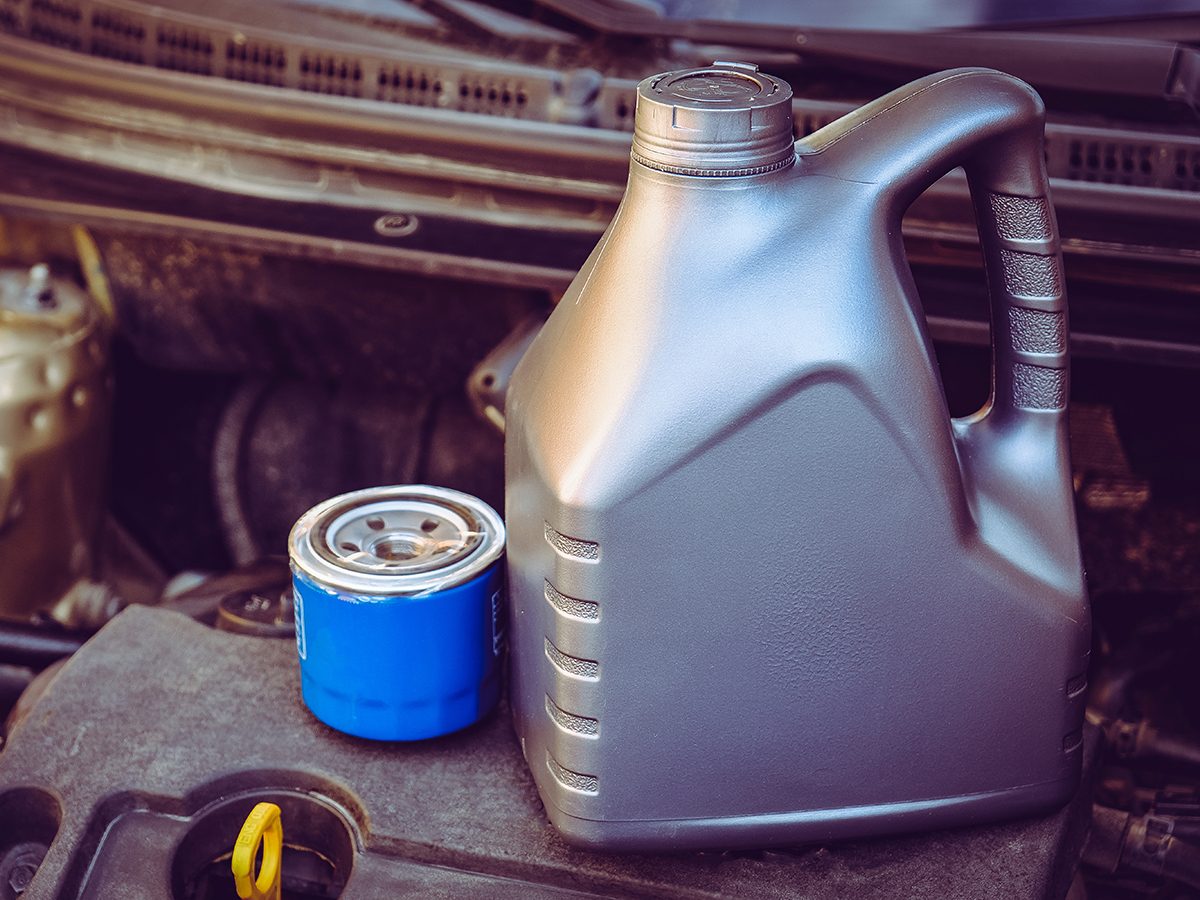
Considering switching to a high mileage oil filter?
Old cars can actually benefit more from high mileage oil filters and motor oil than newer models. Combustion gases always leak past the piston rings and into the oil (even in new engines). The gases then condense to form corrosive acids. New engine oil contains enough acid neutralizers, anti-corrosion agents, detergents and foam inhibitors to counteract the effects of normal blow-by. But the extra blow-by in older engines causes the additives to wear out sooner. That’s where high mileage (HM) oil comes in handy.
HM oils (about 75¢ more per litre) are formulated to handle the extra load and are well worth the money. To get even greater protection, add a high-mileage oil filter, too. High-mileage filters contain a capsule of additive gel that dissolves slowly over a 5,000-kilometre period. So it continually feeds new additives into the oil. Together, HM oil and an HM filter add less than $7 to the cost of an oil change. It’s a good investment to keep your old wreck running longer.
Now that you know about high mileage oil filters, try this simple hack so you’ll never miss another oil change.
Nudged awake by the morning sun, the young cougar opened its jaws in a teeth-baring yawn and stretched its muscular forelegs. Then it started down the mountainside, crossed a narrow highway and loped toward the wide, rushing river. For days, the cougar had been edging closer to the small lumber village of Lillooet on the Fraser River, at the edge of the mountains of southern British Columbia. Now, after drinking the river’s cold water, the cougar bedded down again in the nest of tall grass.
On July 3, 1991, the five children in Larrane Leech’s day-care group were outdoors early, painting bright tempera landscapes under the penetrating sun. By 10 a.m. it was time to find shade, so Larrane decided they would walk down to the river. “We’re going to pick berries now,” she announced.
At 44 years old, she had made one of her dreams come true when she turned her home into a daycare centre. It had taken hard work and determination to get her certification. After completing her course work in early-childhood education, she had worked as a volunteer in a daycare centre, while holding down a job at the local lumber mill and raising three teen sons alone.
So far, the centre was operating smoothly. But it was too soon to tell whether the families she worked for would be happy with it. And she worried about being able to care for enough children to make the business pay off.
Venturing Into the Outdoors
Larrane had known all five children in her care since they were infants. Three were siblings: playful Mikey, age two; Jessica, five, the exuberant leader; and three-and-a-half-year-old Alleshia Allen, the tough little athlete. Four-year-old Natani Leech, the long-haired beauty, was actually their aunt, and Larrane in turn was her aunt. Only the bubbly toddler Lisa O’Laney, a few months shy of two, was unrelated to them. All were members of Indigenous tribes clustered around Lillooet, more than 160 kilometres northeast of Vancouver.
The children had fallen easily into Larrane’s daily routine. A nature lover, she insisted they spend as much time as possible outdoors. Everyone loved circle time, when they passed around a black and white eagle feather; the child who held it could then talk about whatever they wanted.
After clearing away the painting supplies and handing each child an empty jar, Larrane called for Pal, her one-year-old part-German shepherd. Giggling with anticipation, Jessica and Natani paired off in front. Larrane linked Mikey’s hand with Alleshia’s, took little Lisa’s in her own and said, “Let’s go.”
Larrane’s house stood on a wooded slope not far up from the mighty Fraser River. The group made its way over the dusty gravel road and then onto a dirt trail through the trees. The two oldest girls broke into a run through the tall brown grass at the trail’s edge, Natani’s waist-length hair swaying back and forth. Larrane and the little ones hurried to keep up.
Stopping the children at the first berry bush, Larrane pointed to the long, thin branches bearing clusters of plump, sweet navy-blue fruit. “Look, the berries are all over,” she said. She helped Lisa find some clusters on the lowest branches. Mikey watched, then tentatively bit into one of the berries. “Mmmmmm, good,” he said, and got busy plucking more.
The cougar cocked an ear toward the birdlike chatter and reflexively sniffed the air. Cougars rarely attack people or show themselves, but as towns expanded into mountainous countryside, there had been more and more sightings, especially in southern British Columbia. At the time, the province was home to some 3,000 of them.
The young cougar was instinctively versed in hunting strategies: step silently and downwind through the brush to avoid being heard, scented or seen; choose the weakest prey and attack from behind, clamping powerful jaws on the vital nerves and blood vessels of the prey’s neck.
Larrane and the children moved slowly from bush to bush. Pal stopped frequently in the shade, panting. In 20 minutes, the children filled their jars and were almost to the river. Here, the ground fell steeply to a cool, shady strip of sand about four metres wide.
“Okay,” Larrane commanded after the group clambered down to the sandbank, “let’s get in our circle.” She could not risk letting a child wander off. Suddenly Alleshia jumped up and scooted toward the trees. “Come back, Alleshia,” Larrane called. Running after her, she caught up with the child and leaned over to help her back to the sandbank.
The Cat and Its Prey
Now the cougar could see the funny little creatures that had been making all the noise. Automatically, its predatory machinery kicked in. These were perfect prey: small, wiggly and oblivious to any possible attack.
Stepping over the thick carpet of pine needles, the cat slunk toward the children, never so much as rustling a leaf or snapping a twig. Then it did something remarkable, something only a young, inexperienced cat would do. It walked onto the bank and merely nudged one of the children, the young boy, Mikey, backward onto the sand. The rules of hunting required that the cougar grab the boy’s head in its mouth and carry him away. But the young cat paused, and to remove any hair before attacking and feeding, it began to lick the boy’s smooth skin with its rough tongue.
Larrane sensed the children suddenly go quiet. She looked up to see the back end of a cat the size of Pal standing over Mikey. The cat’s head was down, out of sight behind its peaked shoulder blades, and its plumped, black-tipped tail swiped back and forth like a whip.
Larrane was momentarily frozen by the sight. Now Natani was giggling nervously. “Stop licking Mikey’s face,” she said playfully, as though talking to a house cat.
Larrane couldn’t tell whether Mikey had been bitten; he was silent and hidden beneath the beast. Her mind racing wildly, she sprang impulsively toward the cougar. Blindly intending to grab its tail, she shifted aim at the last minute and seized the cat by the scruff of the neck. Tugging once, she shook it from side to side.
Instantly, the cougar unsheathed its claws and wheeled toward Larrane, swiping Mikey’s face and Lisa’s too. Growling and hissing, it stretched up high and brought its paws down upon the head of the five-foot-one-inch woman. As she stumbled backward, one paw slipped onto her right shoulder, the claws grazing her ear.
This animal was capable of killing her. Although still in its youth, it had all the teeth and muscle a cougar needs to pull down a victim three times its size.
Aware now of the danger, four of the children shrieked and ran behind Larrane. Mikey lay still on the ground.
“Stay behind me,” Larrane screamed as she faced the beast. Acting before she could think, she grabbed the animal’s forelegs and pulled them off her. The cougar’s thrashing forced her back into a crouch. Her soft sandals shifted and slipped in the sand, making it difficult to keep a secure stance. Summoning all her strength, Larrane forced herself back upright, still grasping the cat’s thick legs. Then she thrust her arms forward and locked them straight out in front of her. At the same time, she used her thumbs to push the animal’s paws inward to protect herself from being cut.
“Pal, do something!”
Locked in a deadly dance with the cougar, Larrane felt as though she were watching herself in slow motion. She stared at the animal’s pink tongue and long ivory fangs. Stepping back and forth on its hind legs, the cat let out a menacing growl as it tried to tug its paws with their sharp claws away from her.
“Pal, do something!” Larrane yelled at the dog cowering on the sand not three metres away. She felt the muscles in her arms, legs and back weakening. What in the world am I going to do? she thought. No one will ever find us here, and if the cat gets away from me, he’ll surely kill the children. “Just go away and leave us alone,” she yelled into the animal’s face. “Leave us alone, and we’ll leave you alone.”
The cougar was now trying a new tactic to break Larrane’s grip. It began thrashing its upper body from side to side, and Larrane could sense its imminent escape. Again acting without any conscious plan, she arched her back to gather momentum, then shoved forward with all her might, thrusting the cat directly at the dog and shouting, “Pal, do something!”
The cougar fell backward but rolled instantly onto its feet and darted past Pal through the brush farther along the sandbank.
Without knowing it, Larrane had responded perfectly. She had distracted the cougar from Mikey only a fraction of a second before it had a chance to crush the boy’s skull in its mighty jaws. Then her aggressive movements and loud shouting probably scared the animal. Cougar experts say the cats often lose their appetite for killing when angrily confronted.
Watching the cat retreat, Pal gave chase, barking madly. In one bound, the cougar leaped halfway up a pine, then climbed to the top, wrapped its paws around a branch and hung there, looking down at the dog.
Larrane rushed to Mikey, who lay quietly on the sand. The left side of his face and neck was bathed in blood. But he was breathing, and his eyes were open so wide they seemed to bulge from his face.
He’s alive, Larrane thought, gasping in relief. But he was eerily still. He must be in shock, she decided as she pulled him into her arms.
Then her eyes fell on Lisa, wailing at her side. The girl’s face was also covered with blood.
Shifting Mikey to her right side and scooping Lisa up in her left arm, Larrane called to the other children. “We have to run home now.” She saw their terror as they looked at her. She touched her face and felt blood dripping. It’s scaring them just to look at me, she realized. “Let’s go,” she ordered, “as fast as we can!”
A Quick Escape
They scrambled up the hill, Lisa still crying, Mikey remaining silent. Larrane soon found the two children too heavy to carry and eased Mikey down. He suddenly jolted from his stupor. “Owie, owie, owie!” he screamed, tears coursing down his face.
Larrane pulled him along toward the house. Pal lingered behind, watching the cougar, before finally following the others. “Everything will be all right,” Larrane called out to the kids. But deep down, she was not so certain. The cougar could be anywhere. She considered what it had already done—to Lisa, to Mikey and to the dream she had worked so long to realize. Would any parents trust her with their children after this?
In five minutes, they were all inside the front door. Suddenly Larrane was aware of her own pain. Her thighs were bruised, and the scratches on her arm, forehead and ear burned. Her hands shook as she telephoned the hospital and the parents of Lisa and Mikey.
At the Lillooet Hospital, Mikey needed 40 stitches to close the lacerations on his chin and neck, but all his wounds were shallow. Lisa had been lucky too. The cat had clawed within an inch of her right eye. The doctors used 20 stitches to repair the cuts on her face, and gave both children tetanus shots.
Larrane’s scratch needed only to be cleaned and left to heal. But the muscles in her arms, back and legs were so sore that she had difficulty walking.
The next morning she felt profound relief when she opened the front door to four of her day-care children—including Mikey. Only Lisa did not return.
For several days, as they sat in a circle passing the eagle feather, the children remained quiet. The pictures they painted at art time were showered with splatters of red.
Finally, a week later, Mikey took the eagle feather in his hand and said, “I had a dream last night.”
“And what did you see in your dream?” Larrane asked gently.
“I saw an eagle. And he was sitting on my bed. Then he flew over me.”
Larrane smiled. In Lillooet folklore, the eagle is a sight of strength, sent by ancestors as an assurance that the person who sees it will be kept safe. She knew the child was beginning to feel secure again.
Larrane felt secure too. She had met the greatest challenge of her life head on. Her friends and neighbours applauded her strength. And now, she felt, she could accomplish anything.

Police and a local conservation officer set out in search of the cat immediately after the attack was reported. Nine days later, the cougar wandered into Doug Johnston’s yard, one and a half kilometres north of Larrane Leech’s house. Johnston called his neighbour Dayle Turley, who came over with a shotgun and killed the cat.
In December 1992, Governor General Ramon John Hnatyshyn awarded Leech the Star of Courage. The village of Lilloeet also gave her a commendation for “outstanding bravery.”
Leech continued running a daycare out of her home for several more years. She passed away on September 14, 2020, at age 73.
Next, read this heart-pounding story of a rogue bear on the rampage.

